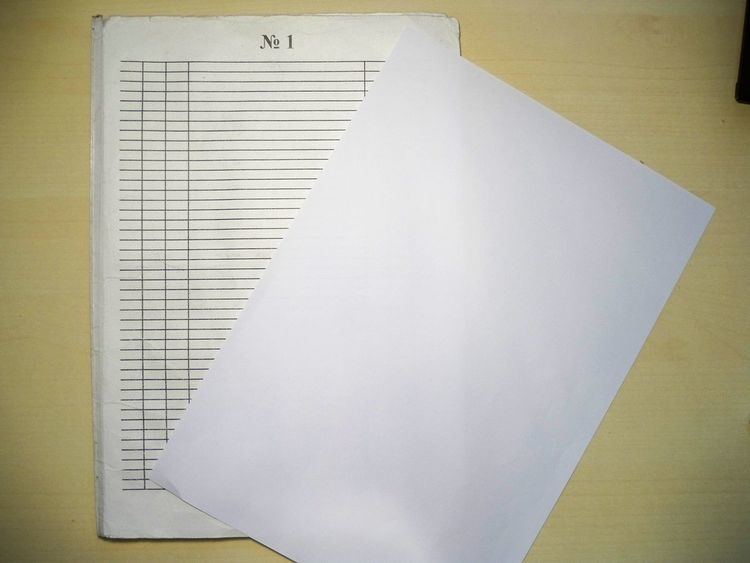Ruled paper (or lined paper) is writing paper that typically consists of horizontal lines meant to separate lines of hand-written text, and vertical lines meant to provide margins or to act as tab stops.
A popular alternative to lined paper is graph paper (square paper or grid paper). It is a grid layout in which horizontal and vertical lines are equally spaced, dividing the page into squares.
There are many types of ruled paper. Lines are drawn on paper according to the needs of the users. Some types of ruled paper are for calligraphy, making graphs, or writing music, whereas others are for teaching students how to write in a particular language or script, etc.
The type of ruling is not typically tied to any particular paper size. Instead, it is usually determined by the purpose, style of handwriting, and/or the language being written.
Lines on ruled paper are typically used as guidelines to help the user keep their writing or drawing consistent with a predetermined set of rules. Some generic categories of lined paper are as follows:
Notebook paper (or Writing paper, Filler paper, Loose leaf paper, Binder paper) is typically used for handwriting. It is produced in different layouts and sizes. The specific size and layout is determined by the need or region. The layout usually consists of evenly spaced horizontal lines with vertical lines drawn to indicate margins, the middle of the page, or sections of a line. The number of vertical lines varies by region. (see below)Graph paper is used for drafting, drawing, etc.Quadrille ruled paper (colloquially, "quad paper") has horizontal and vertical lines which are both evenly spaced over the entire page, creating a grid of squares. These evenly spaced squares help to keep things lined up. In addition to creating graphs and diagrams, students often use graph paper to help keep numbers in columns when doing manual operations such as long division or long multiplication.Semi-log ruled paper is similar to quadrille ruled, except the horizontal lines are drawn according to the logarithmic scale, and so the lines are not evenly spaced.Log-log ruled paper is similar to quadrille ruled, except that both the horizontal and vertical lines are drawn according to the logarithmic scale.Music manuscript paper is used when handwriting music. The most basic page is laid out with a series of five-line staves, each spanning the width of the page. Any musical notation (clefs, bars, notes, etc.) may be written in as desired by the artist. As notebook paper is to the written word, music manuscript paper is to the written score.Elementary students use Tianzigezhi ruled paper.
In France, in order to foster handwriting discipline, a type of ruling known as Seyès ruling is used on paper in schools. Heavy horizontal lines are printed 8 mm (appx. 5/16 in) apart, with three lighter lines 2 mm (appx. 5/64 in) apart between each pair of heavy lines. Heavy vertical lines are spaced 8 mm (appx. 5/16 in) apart, beginning 16 mm (appx. 5/8 in) from the left-hand edge of the page. These sheets of paper are generally known as grand carreaux (large tiles) as opposed to the petit carreaux (small tile) which are 5x5mm. Seyès ruled paper is available in single sheets or joined double sheets which are sometimes preferred for exams, being easier to handle.
DIN 16552:1977-04 (“Lines for handwriting”) specifies the types of ruled paper to be used by school pupils.
Among others, genkō yōshi is a kind of paper for manuscript writing specific to the Japanese language.
New Zealand
In 1984, Standards New Zealand instituted an official standard for school stationery which specified standards for ruled and unruled paper.
In the United States, ruled paper is available in a variety of semi-standardized formats:
Narrow ruled paper has 1⁄4 in (8⁄32 in, 6.4 mm) spacing between ruling lines, and is used by those with smaller handwriting or to fit more lines per page.Medium ruled (or College ruled) paper has 9⁄32 in (7.1 mm) spacing between horizontal lines, with a vertical margin drawn about 1 1⁄4 inches (32 mm) from the left-hand edge of the page. Its use is very common in the United States.Wide ruled (or Legal ruled) paper has 11⁄32 in (8.7 mm) spacing between horizontal lines, with a vertical margin drawn about 1 1⁄4 inches (32 mm) from the left-hand edge of the page. It is commonly used by American children in grade school, as well as by those with larger handwriting.Gregg ruled paper has ruling specialized for stenography. It has 11⁄32 in (8.7 mm) spacing between ruling lines, with a single margin drawn down the center of the page.Pitman ruled paper has ruling specialized for stenography. It has 1⁄2 in (12.7 mm) spacing between ruling lines, with a single margin drawn down the center of the page.Manuscript ruled paper is used to teach young children how to write. A blank sheet consists of rows of three lines (the space between them depends on the age group being taught) with the middle line in each three-line set being dotted. The D'Nealian writing style is a well-known teaching method that makes use of this type of paper ruling. Another educational institution, A Beka Book, utilizes this ruling along with a house metaphor (upstairs, downstairs, and basement) to help young children learn where parts of each letter should be written. The usage is similar in concept to the use of the horizontal lines on French Seyès rule paper.There is cursive paper for the Cyrillic alphabet.

